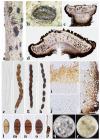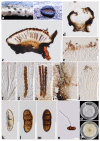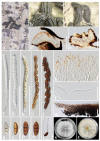Additions to Rhytidhysteron (Hysteriales, Dothideomycetes) in China
- PMID: 36836263
- PMCID: PMC9958654
- DOI: 10.3390/jof9020148
Additions to Rhytidhysteron (Hysteriales, Dothideomycetes) in China
Abstract
In this study, twelve terrestrial hysteriaceous saprobic fungi growing on different pieces of dead wood were collected from Yunnan Province, China. All hysteriaceous strains isolated in this study tallied with the general characteristics associated with Rhytidhysteron. Detailed morphological characteristics and combined multigene phylogeny of LSU, ITS, SSU, and TEF showed that the twelve hysteriaceous fungi strains represent four distinct new species, and seven new host or geographical records of Rhytidhysteron. Based on morphological and phylogenetic evidence, the four new species (Rhytidhysteron bannaense sp. nov., R. coffeae sp. nov., R. mengziense sp. nov., and R. yunnanense sp. nov.) expand the number of species of Rhytidhysteron from thirty-three to thirty-seven, while seven new geographical records expand the records of Rhytidhysteron in China from six to thirteen. In addition, 10 new Rhytidhysteron host records are reported for the first time, thus expanding the known hosts for Rhytidhysteron from 52 to 62. Full descriptions, images of the morphology, and phylogenetic analyses to show the position of the Rhytidhysteron taxa are provided. In addition, the present study summarizes the main morphological characteristics, host associations, and locations of this genus.
Keywords: Ascomycota; Hysteriaceae; four new species; hysteriaceous; saprobes; seven new records.
Conflict of interest statement
The authors declare no conflict of interest.
Figures





Similar articles
-
Melomastia (Dothideomycetes, Ascomycota) species associated with Chinese Aquilaria spp.MycoKeys. 2024 Dec 4;111:65-86. doi: 10.3897/mycokeys.111.137898. eCollection 2024. MycoKeys. 2024. PMID: 39669742 Free PMC article.
-
Taxonomy and phylogeny of the novel rhytidhysteron-like collections in the Greater Mekong Subregion.MycoKeys. 2022 Jan 12;86:65-85. doi: 10.3897/mycokeys.86.70668. eCollection 2022. MycoKeys. 2022. PMID: 35095305 Free PMC article.
-
A molecular phylogenetic reappraisal of the Hysteriaceae, Mytilinidiaceae and Gloniaceae (Pleosporomycetidae, Dothideomycetes) with keys to world species.Stud Mycol. 2009;64:49-83S3. doi: 10.3114/sim.2009.64.03. Stud Mycol. 2009. PMID: 20169023 Free PMC article.
-
Three new species of Rhytidhysteron (Dothideomycetes, Ascomycota) from Mexico.MycoKeys. 2021 Sep 14;83:123-144. doi: 10.3897/mycokeys.83.68582. eCollection 2021. MycoKeys. 2021. PMID: 34616220 Free PMC article. Review.
-
Additions to the Inventory of the Genus Alternaria Section Alternaria (Pleosporaceae, Pleosporales) in Italy.J Fungi (Basel). 2022 Aug 24;8(9):898. doi: 10.3390/jof8090898. J Fungi (Basel). 2022. PMID: 36135624 Free PMC article.
Cited by
-
Five new species, two new sexual morph reports, and one new geographical record of Apiospora (Amphisphaeriales, Sordariomycetes) isolated from bamboo in Yunnan, China.Front Cell Infect Microbiol. 2024 Dec 11;14:1476066. doi: 10.3389/fcimb.2024.1476066. eCollection 2024. Front Cell Infect Microbiol. 2024. PMID: 39720793 Free PMC article.
-
Fungi from Malus in Qujing, China: two new species, three new records, and insights into potential host jumping and lifestyle switching.Front Cell Infect Microbiol. 2025 Mar 11;15:1517908. doi: 10.3389/fcimb.2025.1517908. eCollection 2025. Front Cell Infect Microbiol. 2025. PMID: 40134789 Free PMC article.
-
Melomastia (Dothideomycetes, Ascomycota) species associated with Chinese Aquilaria spp.MycoKeys. 2024 Dec 4;111:65-86. doi: 10.3897/mycokeys.111.137898. eCollection 2024. MycoKeys. 2024. PMID: 39669742 Free PMC article.
-
New Aquilariomyces and Mangifericomes species (Pleosporales, Ascomycota) from Aquilaria spp. in China.MycoKeys. 2025 Jan 13;112:103-125. doi: 10.3897/mycokeys.112.139831. eCollection 2025. MycoKeys. 2025. PMID: 39839667 Free PMC article.
References
-
- Hyde K.D., Jones E.B.G., Liu J.K., Ariyawansa H., Boehm E., Boonmee S., Braun U., Chomnunti P., Crous P.W., Dai D.Q., et al. Families of Dothideomycetes. Fungal Divers. 2013;63:1–313. doi: 10.1007/s13225-013-0263-4. - DOI
-
- Chethana K.W., Manawasinghe I.S., Hurdeal V.G., Bhunjun C.S., Appadoo M.A., Gentekaki E., Raspé O., Promputtha I., Hyde K.D. What are fungal species and how to delineate them? Fungal Divers. 2021;109:1–25. doi: 10.1007/s13225-021-00483-9. - DOI
-
- Hongsanan S., Hyde K.D., Phookamsak R., Wanasinghe D.N., McKenzie E.H.C., Sarma V.V., Boonmee S., Lücking R., Pem D., Bhat J.D., et al. Refined families of Dothideomycetes: Dothideomycetidae and Pleosporomycetidae. Mycosphere. 2020;11:1553–2107. doi: 10.5943/mycosphere/11/1/13. - DOI
-
- Wijayawardene N.N., Hyde K.D., Dai D.Q., Sánchez-García M., Goto B.T., Saxena R.K., Erdoğdu M., Selçuk F., Rajeshkumar K.C., Aptroot A., et al. Outline of fungi and fungus-like taxa—2021. Mycosphere. 2022;13:53–453. doi: 10.5943/mycosphere/13/1/2. - DOI
Grants and funding
LinkOut - more resources
Full Text Sources

